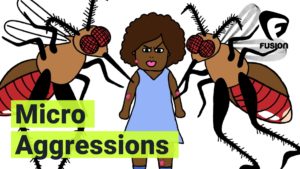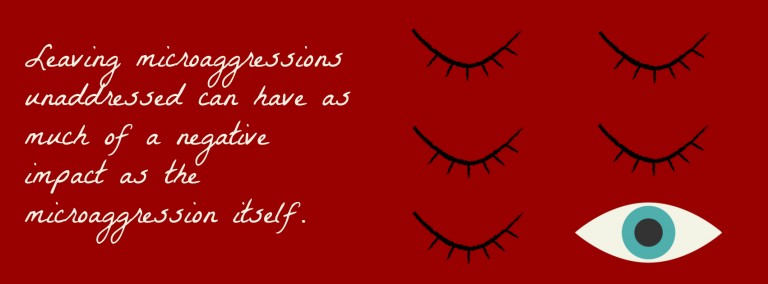Definition
Derald Sue’s oft-cited definition:
“brief and commonplace daily verbal, behavioral, or environmental indignities, whether intentional or unintentional, that communicate hostile, derogatory, or negative racial slights and insults toward people of color.”
WomeninTC have expanded this slightly to be:
“brief and commonplace daily verbal, behavioral, or environmental indignities, whether intentional or unintentional, that communicate negative, indirect, subtle, or unintentional discrimination against members of a marginalized group.”
 Here’s a great short video that helps to define and explain what microaggressions are
Here’s a great short video that helps to define and explain what microaggressions are
https://www.youtube.com/watch?v=hDd3bzA7450
It is important to try and develop strategies handling miocroagressions, and we suggest thinking in terms of ways to intervene by
- Making them visible
- Countering them
- Handling them
- Failing with grace
Luncheon Group Scenario
Following is the scenario we discussed as a group during the luncheon along with some potential strategies.
Quiet tyranny of the “Boys Club”
A senior professor issues an invitation for beer & bonding to faculty, justifying the gathering by saying discussions will ground program decisions and setting the time at 4 PM on a school day. All female faculty respond that they cannot meet at 4 on a weekday because of childcare responsibilities. There is no response. The next week a similar email is sent, listing all who attended (no women attended) and proclaiming that much planning was started and would be advanced at this meeting. When a male faculty member demures because his wife cannot handle childcare on the meeting date, the meeting convener apologizes and postpones the second meeting.
(How) should women faculty (who will never be able to join the group and properly care for their children) respond?
Here are the strategies that the tables came up with at the luncheon:
- Find someone invested (and who is an ally) and talk one on one about the situation.
- Get some colleagues and go together to the person who’s calling the meeting
- Go to faculty women’s association or other orgs where you can talk about this anonymously (such as the ombuds office)
- Trying to find other allies in your institution who may be in similar situations. work on strategies as a team with other allies.
- Calling on allies who have cultural capital in this same situation
- Counter the idea that child care is a women’s problem.
- To gather all the folks together who have these complaints so their collective response to protect those that are vulnerable. Joint statement.
- Thinking about intersectionality in different ways such as considerations of rank and institution and how those differences can lead to handling the situation.
- As a collective group, pose an alternative strategies from meeting times and locations to better ways to deal with this issue in the future.
- Making it the institution’s problem. Finding the right person and use institutional policies and language so its not a personal problem. In other words, frame the response from an institutional standpoint rather than a personal one.
- Separating programmatic development from the social. Suggest that the work that needs to be done be scheduled at a time during conventional work hours.
- Direct approach and just talk with the main person in charge and point out the problem.
- Be certain to express concerns with a rational appeal complete with evidence and justification so as to increase the potential of the audience listening. (in other words, keep the focus on the actual issue rather then the (emotional) response to it.)
- Face to face is key.
Other Scenarios
Classroom microaggressions
- Having a single person represent an entire segment
- Asking women to serve as secretaries on teams
- Differences in teaching evaluations and feedback about teaching (formal and informal) due to race/gender
Microagressions in assessment documents
Faculty are asked to reflect on their teaching in their annual activity reports. Women often reflect on what they need to change or improve; men reflect on what they have accomplished. Consequences include P&T committees having discussions about what is wrong with the female faculty member’s teaching.
Small micro-aggressions
- In a curriculum planning meeting, a senior male colleague who has said little previously, asks a specific junior female colleague’s thoughts “because we haven’t heard from her yet” then counters every comment discrediting hers.
- The ongoing comments about the way women dress. (A VP of academic affairs was recently told by the new president that he was impressed that she dressed so well based on her background.) Comments range from what may seem to be innocuous comments about a “nice outfit” to more directed comments about the amount of cleavage shown or the “appropriateness” of the outfit.
- When you direct a program or initiative and one member will only send messages and questions to your male department chair.
- You are a woman of color. You receive an email from a faculty member that you have only had brief contact with in faculty meetings. She asks if you are interested in designing a course about critical race theory. You have not articulated an interest in critical race theory or any issues regarding race in research or pedagogy.
- A student refuses to address you as “Doctor” or “Professor” despite numerous requests that he do so.
- During a lecture on culture, you ask students to think about different cultures that they are familiar with or different cultures in which they participate. One student raises his hand and asks if “rape culture” is a valid response.
- The chair of your department wants to create a “collegial environment” in the department. The chair decides that once a month the faculty will meet at a nearby bar in the early evening. You have children and cannot attend because you cannot bring your children to the bar.
- A faculty member makes a comment on the department listserv that likens departmental rules to “Jim Crow Laws.”
- A faculty member keeps asking you when he will have a chance to meet your husband.
- A faculty member asks if you attended a recent protest about minority rights. When you inform the faculty member that you did, she asks if the protest was “peaceful” and then proceeds to share that she thinks people take protests more seriously when they don’t resemble “riots.”
- Your department is hiring for a handful of new positions. You are the only minority woman and a junior professor in the department. You have been asked to sit on each one of the hiring committees.
Online Resources

Students See Many Slights as Racial ‘Microaggressions
https://www.nytimes.com/2014/03/22/us/as-diversity-increases-slights-get-subtler-but-still-sting.html?_r=0
Microaggressions Matter
https://www.theatlantic.com/politics/archive/2015/09/microaggressions-matter/406090/
Examples of Microaggressions in the Classroom
http://www.messiah.edu/download/downloads/id/921/Microaggressions_in_the_Classroom.pdf
From Depaul University’s Teaching and Learning Center
http://tlcp.depaultla.org/microaggressions/
Good overview in the powerpoint and then additional resources listed at the bottom.
Navigating Difficult Dialogue In The Classroom
https://conditionallyaccepted.com/2014/02/18/microaggressions/